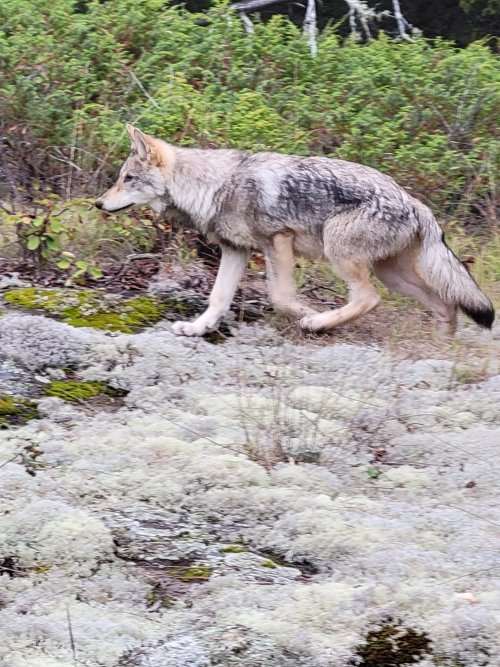cheeser
Well-known member
Hungry as a WOLF
HOUGHTON — A warning for campers on Lake Superior’s Isle Royale National Park: Wolves are venturing into campground trash cans for easy meals. The park reminds visitors to secure and monitor food and trash to keep people and wolves separate and safe. “Wolves are very opportunistic and will...

An Isle Royale wolf is pictured. (Photo courtesy of the National Park Service)
HOUGHTON — A warning for campers on Lake Superior’s Isle Royale National Park: Wolves are venturing into campground trash cans for easy meals. The park reminds visitors to secure and monitor food and trash to keep people and wolves separate and safe.
“Wolves are very opportunistic and will utilize just about anything as a food source, and obviously getting in the garbage is an easy one,” said Brian Roell, the Michigan Department of Natural Resources’s large-carnivore specialist.
Liz Valencia, who manages cultural resources for the national park, said a couple of wolves started knocking down trash cans at the Rock Harbor campground, one of the park’s busiest areas.
Rangers’ efforts to secure trash cans and scare away the wolves failed, she said, and the wolves keep coming back.
So the park is asking visitors to help.
Hikers must keep their packs on them at all times and visitors must keep food and garbage in secure, scent-proof storage, like bear boxes, or hung up in trees at least 10 feet off the ground, according to new regulations that went into effect this summer.
“We just don’t want wolves to get accustomed to being around people,” said Valencia, which could lead to visitors getting hurt by a wolf or vice versa.
]Isle Royale National Park comprises one large island and hundreds of smaller islands, covering 850 square miles. Wolves are essential to Isle Royale, and they’re “a cherished part of the wilderness experience” for visitors, said Valencia.
The possibility of wolf and moose sightings draws in visitors from around the country to the park every year, which isn’t a problem, said Valencia, as long as those sightings are from a distance.
“Seeing a wolf digging through the garbage at Rock Harbor is not really the kind of wolf sighting you want,” she said.
Apart from being an exciting sight for visitors, the gray wolf population on Isle Royale plays a vital role as the park’s top predator. Other large predators are absent, the National Park Service says, including bears, coyotes and mountain lions.
Wolves keep the population of moose, another prominent animal at Isle Royale, stable. Biologists have been studying the relationship between the two animals since wolves crossed over on an ice bridge from Canada in 1948, making it the longest predator-prey study in the world, said DNR biologist Roell.
Efforts to keep the wolf and moose populations thriving have long been the priority of conservationists and scientists.
In 2012, the wolf population decreased drastically, partly due to inbreeding which is becoming more common as warming temperatures keep the lake from freezing over. The annual freezes allowed wolves from Canada to cross over. Without new wolves migrating to the Isle Royale, closely related ones are less likely to produce offspring, and inbred wolves may be born with crooked spines or other health problems.
As an attempt to prevent the species from dying out, the Park Service relocated wolves from the mainland of Michigan, Ontario and Minnesota in 2018 and 2019.
That “was not an easy decision,” said Roell, who was consulted about the issue.
Typically, biologists prefer to let nature do its thing, but without wolves, he said, there was no predator to keep the moose population in check. The whole ecosystem was in threat of collapse. So the relocation of 19 wolves bolstered the genetic diversity of the wolf population and stabilized the park’s ecosystem.
From a low of two wolves in 2018, the population bounced back to 14 in 2020, according to the Park Service.
Valencia said 30 wolves now live in the national park.
EDITOR’S NOTE: Gabrielle Nelson has an environmental reporting internship under the MSU Knight Center for Environmental Journalism’s diversity reporting partnership with the Mott News Collaborative in cooperation with CNS.










